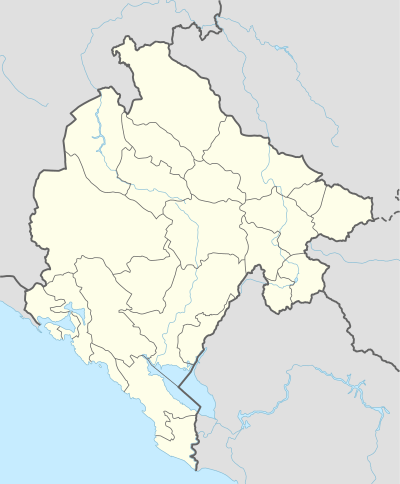Vusanje
Vusanje (Albanian: Vuthaj, Serbian Cyrillic: Вусање) is a small town in Montenegro, located southwest of the town of Plav. According to the 2003 census, the town had a population of 866.
Vuthaj (Vusanje) Vuthaj Вусање | |
|---|---|
Town | |
 Vuthaj (Vusanje) Location of Vusanje in Montenegro | |
| Coordinates: 42°31′46″N 19°50′25″E | |
| Country | |
| Municipality | Plav Municipality |
| Population (2003) | |
| • Total | 866 |
| Time zone | UTC+1 (CET) |
| • Summer (DST) | UTC+2 (CEST) |
| Area code | +382 51 |
| Vehicle registration | GS |
| Climate | Cfb |
Geography
Vusanje is located within the Plav municipality, below the town of Gusinje. It is located in the geographical region of Prokletije mountain, in the basin of the Lim river.[1] There is a notable waterfall Grlja.
History
The village was settled by ancestors of the Kelmendi region of Albania, by Gjonbalaj and Nick Bala family. Until 1912, it was part of Ottoman Empire. During the First Balkan War in 1912 it became part of the Kingdom of Montenegro. The village is made up of two settlements, Katundi i siper (upper village) and katundi i ulet (lower village). Also there is a hamlet called Zarunic. Post 1913, the village was subjected to repression and discrimination from the Montenegrin and Yugoslavian governments. The result was the expulsion of the 90% of the population to the USA, mostly in the New York area. The remaining population is now 100 % Albanian. It has also called Vusenje' and Vušanje. The resident inhabitants call it Vuthaj.
There is an old cemetery in the village, called "the Catholic cemetery".[2]
Culture
There are two mosques in the village (1990).[3]
Anthropology
The village is Albanian-inhabited, one of three Kelmendi settlements along with Martinaj Martinovići and NokshiqNovšići, in the Upper Polimlje region (1958).[1] The majority of families hail from the nearby village Vukël in Kelmend across the border in Albania. The Albanians are native inhabitants in this region.
Families
- Ulaj and Uljević (Albanian: Ulaj)
- Gjonbalaj and Đonbalić (Albanian: Gjonbalaj)
- Ahmetaj and Ahmetović (Albanian: Ahmetaj)
- Vučetaj and Vučetović (Albanian: Vuçetaj)
- Čeljaj and Čelić(Albanian: Çelaj)
- Brunçaj, Bruçaj,
- Kukaj
- Dedushaj
- Qosaj
- Selimaj
During SFR Yugoslavia, families had Serbian(ized) surnames.[4]
Demographics
There is a high demographic vitality in Vusanje in relation to the other villages in the municipality.[5] The village is inhabited exclusively by Albanians,[6] Muslims by religion (2011 census).[7]
| Year | Pop. | ±% |
|---|---|---|
| 1948 | 781 | — |
| 1953 | 859 | +10.0% |
| 1961 | 935 | +8.8% |
| 1971 | 1,103 | +18.0% |
| 1981 | 1,399 | +26.8% |
| 1991 | 1,103 | −21.2% |
| 2003 | 866 | −21.5% |
| 2011 | 648 | −25.2% |
| Source: | ||
Notable people
- Mimoza Ahmeti, Poet
- Isa Qosja, Albanian film director
- Rexhep Qosja (born 1936), Albanian writer and literary critic
- Ahmet Zenel Gjonbalaj, rebel
- Sadri Gjonbalaj, Retired Albanian-American soccer player
- Qerim Sadiku (1919-1946) catholic saint
References
- Barjaktarović 1958, p. 217.
- Barjaktarović 1958, p. 219.
- Madžida Bećirbegović (1990), Džamije sa drvenom munarom u Bosni i Hercegovini, Veselin Masleša, p. 192,
U okolini Gusinja, u selu Vusanje postoje dvije džamije sa drvenom munarom
- Vojska. 8. Vojnoizdavački i novinski centar. 1999. p. 48.
- Marko Knežević. "Проблеми привредног развоја општине Плав као узрок депопулације насеља". Velika.
- "Table N1. Population by etnicity by settlement". Census 2011 data - Settlements. MONSTAT.
- "Table N3. Population by religion by settlements". Census 2011 data - Settlements. MONSTAT.
Sources
- Barjaktarović, Mirko (1958). O grobljima i grobovima u gornjem polimlju. Bulletin du Musée ethnographique de Beograd. Muzej. pp. 217–219.CS1 maint: ref=harv (link)